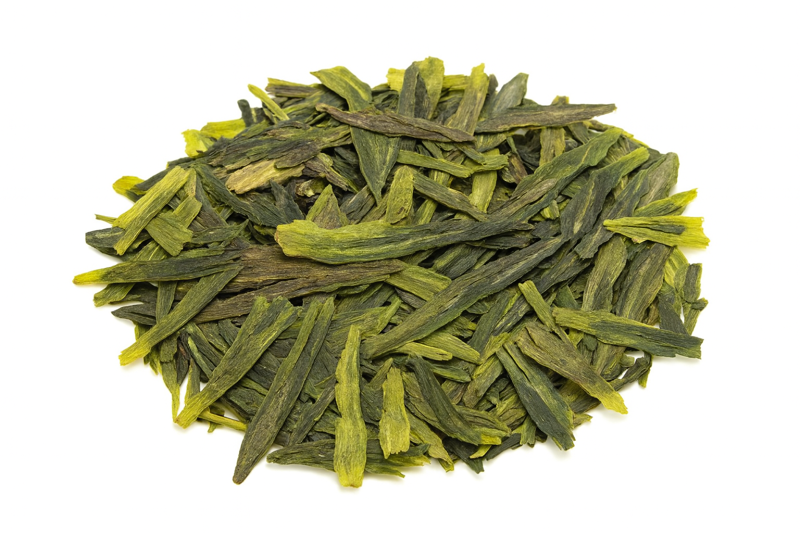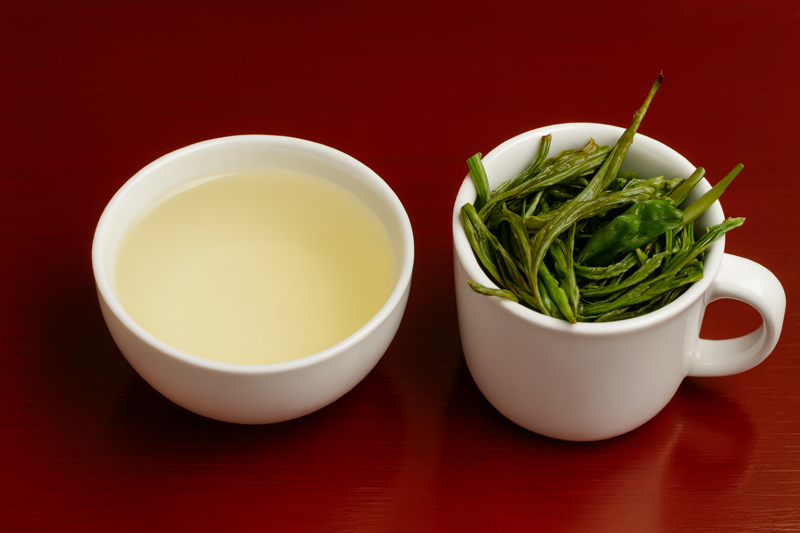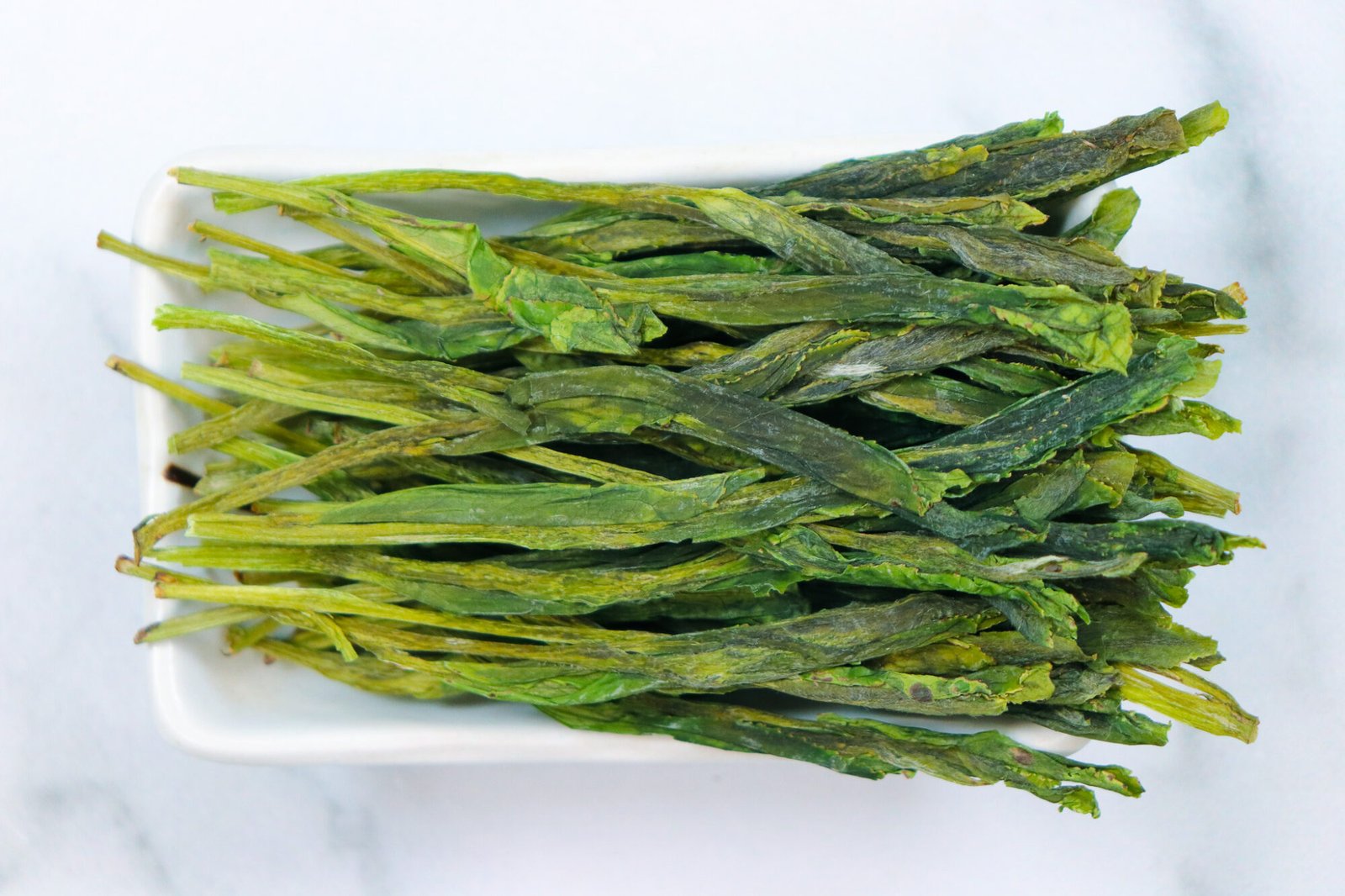Taiping Houkui
Majestic leaves, floral fragrance, and smooth elegance from Anhui’s Huangshan region.
- Category: Green tea (Camellia sinensis), pan-fired.
- Origin: China — Taiping County, Huangshan (Yellow Mountain), Anhui Province.
- Harvest: Early spring (late April to early May), made with one bud and two tender leaves.
- Grade: Supreme Taiping Houkui; High-grade Houkui; Commercial Houkui



Tasting Profile
Brewing Guide
- Tea-to-water ratio~3–4 g leaves per 200 ml water.
- Water temperature75–80 °C (167–176 °F) to preserve floral delicacy.
- Steeping timeFirst infusion: 1.5–2 minutes; subsequent infusions: 30–60 seconds.
- Infusions2–3 infusions; first highlights orchid aroma, second is mellower, third light and refreshing.
Background & Story
Taiping Houkui, often called the “King of Green Tea,” is one of China’s most visually striking and highly esteemed teas. Originating in Taiping County, within the Huangshan (Yellow Mountain) region of Anhui Province, it is instantly recognizable for its unusually large, flat leaves that can reach up to 15 cm in length. These sword-shaped leaves, hand-pressed between cloth mesh during processing, give Taiping Houkui its majestic appearance and distinctive elegance.
The tea’s name carries poetic meaning: “Hou” means monkey, “Kui” means chief or king, and together Houkui is often translated as “Monkey King.” Legend suggests it was named after a local hero or inspired by the resemblance of the bud to a monkey’s paw. Regardless of the origin, the name adds a mythical charm to the tea, enhancing its reputation as something rare and extraordinary.
Cultivation and production of Taiping Houkui began in the early 20th century. Its fame grew rapidly thanks to the ideal terroir of the Huangshan region, where mist-shrouded peaks, fertile soil, and cool mountain air produce leaves rich in flavor and aroma. The harvest occurs in late April to early May, with skilled pickers selecting one tender bud and two young leaves. After picking, the leaves are withered, pan-fired, and then carefully hand-pressed flat. This labor-intensive process preserves both the orchid-like fragrance and the vibrant green color of the leaves.
When brewed, Taiping Houkui offers a pale jade liquor with a delicate orchid aroma, mellow sweetness, and a refreshing finish. Unlike more robust teas, its character is defined by elegance and subtlety rather than intensity. Authentic, high-grade Houkui is rare and often reserved for connoisseurs or special occasions, making it a symbol of prestige in Chinese tea culture.
Today, Taiping Houkui remains one of China’s “Ten Famous Teas,” admired for its beauty, craftsmanship, and refined taste.
Benefits
- Rich in antioxidants that help protect against oxidative stress and aging
- Supports cardiovascular health by aiding circulation and cholesterol balance
- Provides calm focus through L-theanine combined with gentle caffeine
- Helps boost immunity with vitamins, minerals, and polyphenols
- Gentle on the stomach with smooth, low-bitterness flavor suitable for daily drinking
Serving Suggestions
Pairings
- Light seafood dishes such as steamed fish or prawns
- Mild stir-fried vegetables like snow peas or spinach
- Delicate dim sum items such as shrimp dumplings or spring rolls
- Fresh fruit pairings, especially melon or pear
- Light sponge cakes or mildly sweet pastries to complement its orchid notes
Teaware
- Glass tall cup or teapot (to showcase the long, flat leaves unfurling)
- Gaiwan (traditional Chinese lidded cup for delicate brewing)
- Fairness pitcher (cha hai)
Nutrition Facts
Serving Size: 1 cup brewed Taiping Houkui (240 ml)
| Nutrient | Amount per Serving | % Daily Value* |
|---|---|---|
| Calories | 0 | 0% |
| Total Fat | 0 g | 0% |
| Sodium | 0 mg | 0% |
| Total Carbohydrates | 0 g | 0% |
| Protein | 0 g | 0% |
| Vitamin C | 3–6 mg | 5–8% |
| Vitamin A (beta-carotene) | Trace | <1% |
| Calcium | 2–4 mg | <1% |
| Potassium | 20–35 mg | <1% |
| Magnesium | 2–4 mg | 1% |
| Caffeine | 15–25 mg | — |
| L-theanine | 6–10 mg | — |
| Catechins (EGCG) | 25–45 mg | — |
| Polyphenols | 60–90 mg | — |
| Chlorophyll | Present (moderate) | — |
**Percent Daily Values are based on a 2,000 calorie diet.
† Functional compounds such as caffeine, L-theanine, catechins, polyphenols, and chlorophyll do not have established %DV but contribute significantly to Taiping Houkui’s smooth and elegant health benefits.